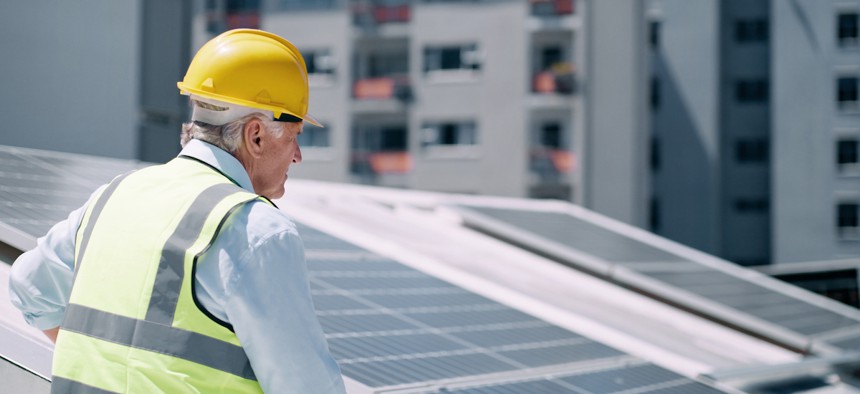$90M awarded to update building energy codes

Sean Anthony Eddy/Getty Images
The U.S. Energy Department grants will provide technical assistance for updating state and local building codes to reduce harmful emissions.
Constructing a sustainable future starts with energy-efficient building codes, at least that’s the goal of the U.S Energy Department’s $90 million grant program.
Building energy codes are design and construction requirements for residential and commercial facilities that support clean energy goals, including reduced carbon emissions. In 2022, residential and commercial buildings accounted for 40% of the nation’s total energy consumption, said Amber Wood, the buildings program director at the American Council for an Energy-Efficient Economy, or ACEEE.
The International Energy Conservation Code traditionally establishes energy models for residential and commercial buildings, but “the actual [enforcement] is all at the state and local level, which is why it’s extremely important to really include and focus on state and local [governments],” Wood said.
“As we think about having larger climate events because of climate change … buildings can provide additional safety, health and resilience benefits,” she said. One way to achieve that is through modern energy codes, which can realize the potential for energy-efficient technologies.
Integrated building management systems, for example, could better control heating and cooling systems to conserve energy. Plus as technology advances, Wood said, grid-interactive efficient buildings could leverage smart technologies to accommodate peaks and drops in energy demand. That’s why energy-efficient equipment in facilities “is critical for resilience,” Woods said.
But according to the Federal Emergency Management Agency, only 35% of communities had adopted modern building codes between 2000 and 2020. The same report projected local governments could have saved $32 billion in climate-related losses had they complied with contemporary building codes.
To prevent further financial loss and improve localities’ climate resilience, Energy awarded $90 million to 26 states and the District of Columbia to mobilize their efforts updating energy codes, the agency said in an announcement yesterday.
The 27 projects, funded through the bipartisan infrastructure law, target initiatives that facilitate data collection, workforce development, equity and environmental justice as well as code compliance and enforcement.
ACEEE received a $9.6 million award to help establish the National Energy Codes Collaborative, which will serve as a peer-to-peer learning network for state and local leaders as they implement building energy codes, Wood said. Four states—Colorado, New Jersey, Michigan and Louisiana—are already members.
The collaborative plans to offer states the opportunity to work with energy code implementation fellows, Wood said, as many state and local agencies have limited staff to address building energy code-related issues. Fellows could help states conduct a workforce gap analysis, for instance, to determine what areas of expertise they currently lack so they can build staff capacity and have as much impact as possible.
Other grant recipients include:
- The California Energy Commission will expand its digital infrastructure to include energy code compliance and implementation.
- The Colorado Energy Office will leverage innovative compliance tools, including remote and/or virtual building inspections, and offer workforce training to enhance energy code adoption and enforcement at the local level.
- The Pennsylvania Department of Environmental Protection will develop training programs targeting building science and energy codes to encourage students in high school and community colleges to join the code inspection and skilled-trade workforce.
A full list of awardees can be found here.
“The upfront cost for energy-efficient [buildings] might be higher, but because of the energy cost savings, you get operational savings and then you definitely have payback,” Wood said.






